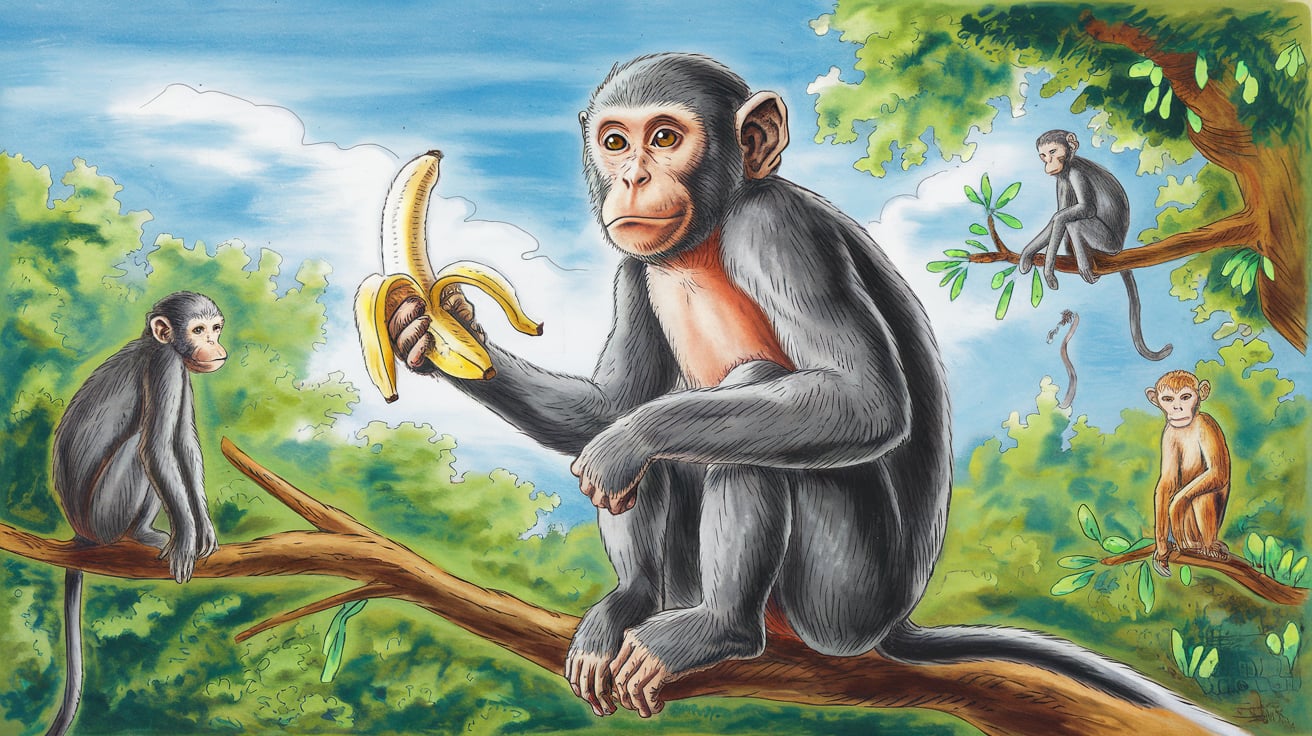Introduction to Monkey Drawing Techniques
Drawing monkeys presents a unique opportunity for artists to explore the complexities of animal anatomy and express their creativity. Monkeys, with their distinctive physical features and dynamic movements, are not only visually intriguing but also evoke a playful spirit that captivates both artists and viewers. The wide variety of species within the primate family highlights the importance of understanding each monkey’s characteristics, from their elongated limbs to expressive facial features.
To excel in monkey drawing, one must begin with a foundational knowledge of monkey anatomy. Understanding key aspects such as skeletal structure, musculature, and proportions is essential. For instance, noticing how a monkey’s center of gravity shifts when they swing from branch to branch can lend fluidity to your sketches. This anatomical awareness allows for accurate representations that capture the essence of these agile creatures, making your artwork resonate with authenticity and depth.
Additionally, drawing techniques should focus on the unique forms and textures of monkey fur, as well as the subtleties of their expressions. Artists benefit from studying various species, finding inspiration in the diverse traits that define them. Chimpanzees, for example, exhibit a range of emotions that can be conveyed through gestures and facial expressions, while macaques often display a mischievous demeanor. By integrating different techniques such as shading, line work, and varying levels of detail, artists can bring their monkey illustrations to life.
In conclusion, mastering the art of monkey drawing not only enhances artistic skills but also offers a pathway to greater creativity. Embracing the unique features and behaviors of these animals is crucial for anyone looking to delve into animal sketching. By honing their techniques, artists can capture the compelling charm of one of nature’s most fascinating creations.
Materials Needed for Drawing a Monkey
Embarking on the journey of drawing a monkey requires a selection of appropriate materials and tools. The first essential item is a set of quality pencils. Beginners should consider starting with a range of graphite pencils, typically from 2H to 6B. The harder pencils (like 2H) are suitable for fine details and initial sketches, while softer pencils (like 6B) are perfect for shading and producing rich dark lines. The versatility of pencils allows artists to convey the intricate textures of a monkey’s fur effectively.
Alongside pencils, an eraser is a crucial tool to have on hand. A kneaded eraser is highly recommended as it can gently lift graphite without damaging the paper, making it ideal for correcting mistakes or softening lines. A vinyl eraser can also be useful for cleaner and more precise erasures. The choice between these erasers can significantly impact the refinement of your drawing.
As for the drawing surface, a sketchbook or drawing paper designed for various media will serve well. For graphite work, medium to heavy weight paper with a smooth texture will enable smooth application of pencil strokes. Some artists may also opt for colored pencils or even pastels to add a vibrant touch to their monkey drawings. If you prefer the digital route, using a tablet with stylus functionality can offer unique capabilities for creating lifelike representations of monkeys.
When selecting your materials, consider investing in high-quality tools that suit your drawing style and preferences, as this will enhance your overall experience and the quality of your artwork. Beginners should focus on basic supplies and gradually explore more advanced techniques and tools as their skills develop. Being equipped with the right materials lays a solid foundation for mastering the art of drawing a monkey.
Understanding Monkey Anatomy and Proportions
When embarking on the artistic journey of drawing a monkey, it is pivotal to have a comprehensive understanding of their anatomy and proportions. Monkeys, belonging to the primate order, exhibit a diverse range of anatomical structures that vary significantly among species. This variation influences their features, which can introduce complexities when attempting to capture their likeness on paper.
In general, most monkeys share certain common traits. For instance, they typically possess a distinct facial structure characterized by forward-facing eyes, which facilitate depth perception essential for life in the treetops. The length of a monkey’s arms is often longer than that of its legs, a trait that is particularly prominent in species such as the spider monkey, which uses its elongated limbs for brachiation. In contrast, some other species have more balanced proportions, like macaques, where the limbs and torso are more evenly matched.
Moreover, the varied tails present in different species must also be considered. For instance, capuchin monkeys exhibit a prehensile tail, which they can use for grasping and climbing, adding an additional layer of complexity to their anatomical representation. When drawing monkeys, artists should pay attention to these specific characteristics, ensuring an accurate and proportional depiction of their subjects.
For illustrative purposes, one can reference diagrams that outline the skeletal framework of various monkey species. Understanding the underlying structure will assist in achieving accurate proportions in artwork. Consider a typical ratio where the head constitutes about one-third of the body length; this guideline will help maintain naturalistic proportions as one transitions to drawing the entirety of the monkey’s figure. By studying these variances and adhering to anatomical principles, artists can enhance the realism and expressiveness in their drawings of monkeys.
Basic Techniques for Sketching Monkeys
To effectively master the art of drawing monkeys, one must first understand and implement several fundamental sketching techniques. These techniques serve as the foundation for creating accurate and dynamic representations of these fascinating creatures.
Begin by breaking down the monkey into basic shapes. This approach simplifies the drawing process, allowing the artist to focus on proportionality and structure. Start with ovals and circles to represent the head and body, and then add rectangles and lines for the limbs. This skeletal framework will serve as a guideline for constructing the main forms, enabling you to visualize the monkey’s posture and position.
Once the basic shapes are established, gradually refine the drawing by adding more detail. Focus on defining the facial features, such as the eyes, nose, and mouth, which are crucial for capturing the character of the monkey. Study the anatomical structure of monkeys as they possess distinct characteristics, such as varying ear shapes and fur patterns, which can greatly influence the overall likeness in your drawing.
Another vital technique is to maintain proportion and symmetry throughout the drawing process. A common struggle in drawing monkeys is accurately depicting their limbs in relation to their bodies. To achieve this, frequently assess the relative size of each part against the others. This method not only enhances accuracy but also contributes to a more dynamic pose that reflects the monkey’s natural movements.
Utilizing techniques such as gesture drawing can also be beneficial. This practice involves quickly sketching the general form and movement of the monkey, allowing the artist to capture the essence of their personality and energy before refining further. By integrating these techniques into your drawing routine, you will foster a more substantial connection with the subject matter, leading to improved skills over time.
Adding Detail and Texture to Your Drawings
To elevate your monkey drawings, incorporating depth and detail is crucial. The realistic portrayal of fur, facial features, and body language can significantly enhance the viewer’s connection to your artwork. One essential technique for depicting texture is the use of varied hatching and cross-hatching strokes. These methods allow the artist to simulate the appearance of dense monkey fur, creating a lifelike quality to the drawing. Start by observing the natural way light falls on the animal’s body; this will guide your shading and textural choices.
When focusing on facial features, pay close attention to the unique characteristics that define a monkey’s expression. The eyes, for instance, can convey a multitude of emotions, from playfulness to curiosity. Using softer pencil strokes for the areas around the eyes can emphasize this expression, while sharper, more deliberate lines can outline the brow and mouth. By varying the pressure applied to your drawing instrument, you can create contrast in your line work, which adds depth and intrigue to your monkey drawing.
Moreover, consider employing different shading techniques, such as stippling or smudging. Stippling, which involves creating patterns of tiny dots, can be particularly effective for capturing the fine strands of a monkey’s fur. Smudging, on the other hand, can be utilized to blend areas, creating smooth transitions between light and shadow. Experimenting with these techniques will help you to find the right balance of detail and texture. It is important to frequently step back from your work to assess the overall impact of the detail you are adding; this will ensure that the drawing maintains a cohesive look. By integrating these strategies into your creative process, your monkey drawings will exhibit enhanced depth and character.
Realistic Monkey Expressions and Poses
Capturing the expressive quality of monkey faces is an essential skill for artists aiming to create realistic representations. Monkeys are known for their diverse range of emotions, reflected in their facial expressions and body language. To accurately portray these expressions and dynamic poses in your drawing, it is crucial to observe real-life monkeys either in their natural habitats or in controlled environments. This allows for a deeper understanding of their behavior and emotional spectrum.
When observing monkeys, pay attention to subtle changes in their facial muscles. For instance, a relaxed monkey may have a slightly open mouth and a gentle gaze, while one that is alarmed will display wide eyes and possibly a bared-teeth expression. The eyebrows, mouth, and even ears can convey a myriad of emotions such as curiosity, aggression, or fear. Incorporating these details into your drawing will enhance the realism of your monkey studies.
Additionally, studying reference images can greatly aid your understanding. Photographic references allow artists to dissect the anatomy of a monkey’s face, revealing how different poses can alter its expression. Try to focus on capturing the essence of movement; a playful monkey swinging from a branch will exhibit characteristics distinctly different from one lounging in the sun. Experimenting with various angles and poses in your drawings will also help develop your ability to portray dynamic action.
Understanding the psychology behind a monkey’s behavior can offer insights into how to represent their expressions accurately. Observing real-life interactions among monkeys can inform your art, leading to more nuanced and lively interpretations. Ultimately, these practices combined will enrich your skill set, enabling you to master the art of drawing monkeys with authentic expressions and poses.

Coloring Your Monkey Drawing: Tips and Techniques
Coloring your monkey drawing is an essential step that can substantially enhance its overall appeal and bring it to life. Whether you choose to use traditional mediums such as colored pencils and markers, or opt for digital coloring techniques, understanding the methods of color application will elevate your artwork. The choice of colors plays a pivotal role in setting the mood of the piece. When depicting monkeys, consider the natural hues found in their fur. Shades of browns, grays, or even vibrant reds can represent various species. Selecting a color palette that aligns with the type of monkey you are drawing will provide authenticity to your work.
When using colored pencils, layering is a significant technique that enables a smooth gradient effect. Start with lighter shades and progressively add darker tones. This process creates depth and dimension, making your monkey drawing more dynamic. Blending is equally important, and you can achieve this through various methods such as using blending stumps, tissues, or even your fingers for softer transitions. Remember to apply gentle pressure to maintain control and prevent damage to the paper.
For artists who prefer digital methods, platforms such as Adobe Photoshop or Procreate offer numerous tools to enhance your monkey artwork. Utilizing different brushes can create textures that mimic fur, enhancing the realism of your drawing. Additionally, digital layers allow fine-tuning of colors without the risk of committing to one shade. Experimenting with opacity and layer effects can lead to impressive results. It is also beneficial to observe how light interacts with the fur, employing highlights and shadows to create dimensionality.
In conclusion, whether you are using traditional or digital techniques, mastering the art of coloring your monkey drawing can significantly impact its final presentation. By understanding color selection, blending techniques, and utilizing various tools, your artwork can achieve the level of excellence it deserves.
Common Mistakes and How to Avoid Them
When it comes to mastering the art of drawing monkeys, a variety of common mistakes can hinder an artist’s progress. Recognizing these pitfalls and learning how to avoid them is an essential step towards improving one’s artistic skills. One frequent error is the misconception regarding proportions. Artists may struggle to accurately represent the unique body structure of monkeys. Instead of adhering to the general proportions seen in other animals, it is necessary to focus on the particularities of a monkey’s anatomy. A helpful approach is to study reference images of various monkey species, noting how their limbs, torsos, and heads relate to one another in size.
Another prevalent mistake involves neglecting the intricacies of facial features. Monkeys have distinct facial expressions and characteristics that can significantly affect the overall portrayal. Failing to capture the essence of a monkey’s expression can result in a lifeless drawing. To enhance expression, artists can practice sketching quickly from images, focusing on the shapes and proportions of eyes, noses, and mouths. Ensuring that these features accurately depict the lively nature of the subject is crucial for an engaging drawing.
Also, many artists overlook the importance of texture and shading. Monkeys have various fur textures and patterns, which add depth and realism to a drawing. Commonly, beginners apply an even shading technique throughout, failing to represent the various tones present in a monkey’s fur. To improve upon this, artists should experiment with different shading methods, focusing on light and shadow through a careful observation of reference materials. By integrating these elements into their work, artists can create more dynamic and lifelike representations.
By being aware of these common errors and consistently practicing, aspiring artists will find that their skills improve significantly, leading to more refined and polished artwork of monkeys.
Showcase: Inspiring Monkey Art from Around the World
Art has long been a medium through which emotions, stories, and culture are expressed, and among various subjects, monkeys have captured the imagination of many artists globally. This unique animal, often regarded for its playful nature and human-like characteristics, serves as a rich inspiration for diverse artistic styles. In this section, we will explore some noteworthy monkey drawings that highlight the creativity and talent of artists from different backgrounds.
One captivating piece is by the contemporary artist Eliezer Tzvika, whose vibrant use of color and abstract shapes in his monkey illustrations evoke joy and whimsy. His style reflects the playful spirit of monkeys, artfully incorporating elements of surrealism. By emphasizing exaggerated proportions and vibrant hues, Tzvika engages viewers in a delightful visual journey that celebrates the essence of these creatures.
Another prominent artist, Ling Chao, draws monkeys with a distinct traditional Chinese influence. Her intricate brushwork and delicate ink washes convey a sense of tranquility and reverence for nature. Each monkey drawing portrays not just the physical attributes but also a glimpse into the character and soul of the animals, rooted in the rich symbolic meanings that monkeys hold in Chinese folklore.
Moreover, artist Rina Patel adds a contemporary twist to her monkey illustrations through the use of mixed media and digital techniques. By combining traditional drawing methods with digital enhancements, she explores themes such as evolution and environmentalism. Each piece invites contemplation on the relationship between human beings and monkeys, positioning them as a critical component of our shared ecosystem.
These inspiring examples illustrate that the world of monkey art is incredibly diverse, with each artist bringing their unique voice and perspective to this subject. Through their varied approaches and techniques, they not only demonstrate their mastery in drawing monkeys but also create space for dialogue about nature, culture, and the human connection to wildlife. In conclusion, the exploration of monkey art from around the world serves as an encouraging reminder of the boundless creativity that can be inspired by a single subject. Whether realistic, abstract, or conceptual, each drawing emerges as an artistic homage to these fascinating creatures.
you may also read


